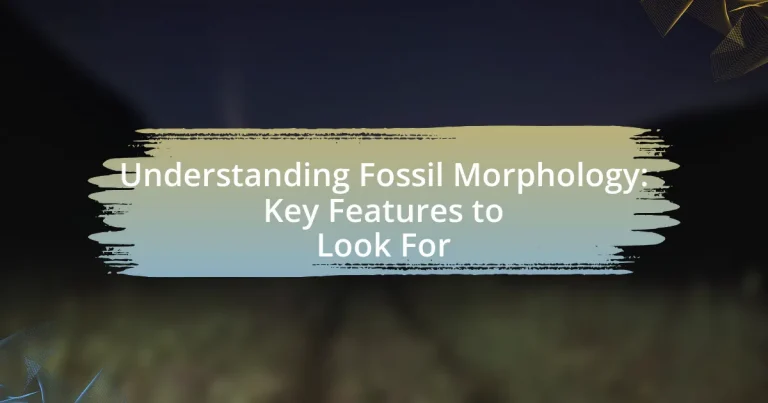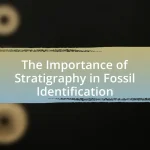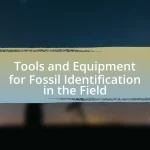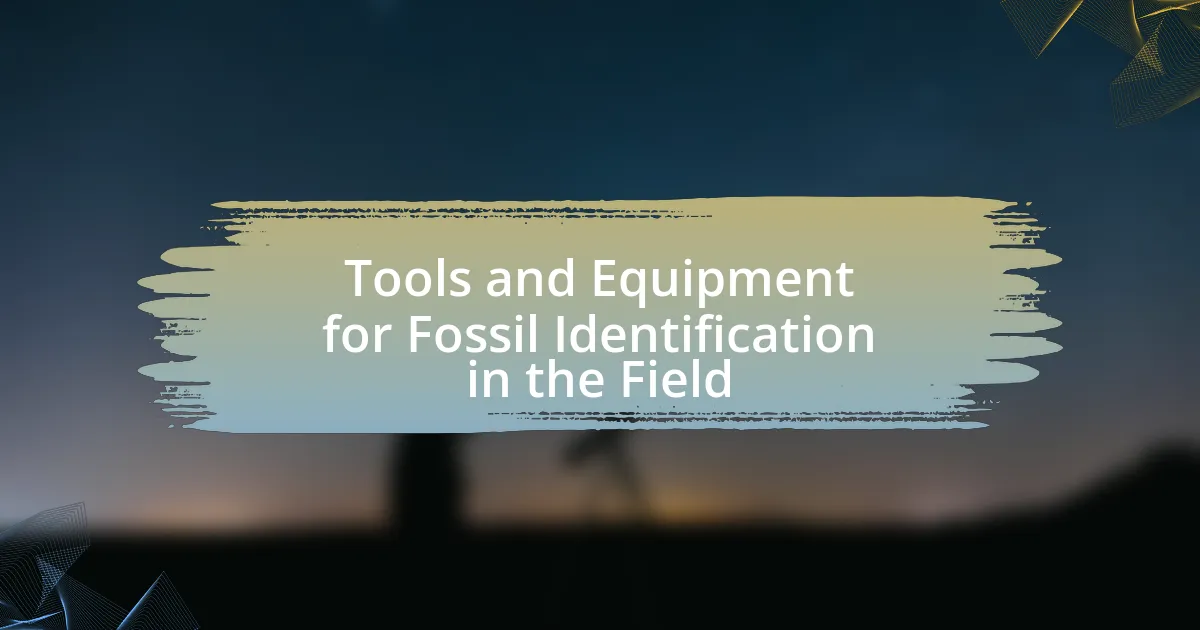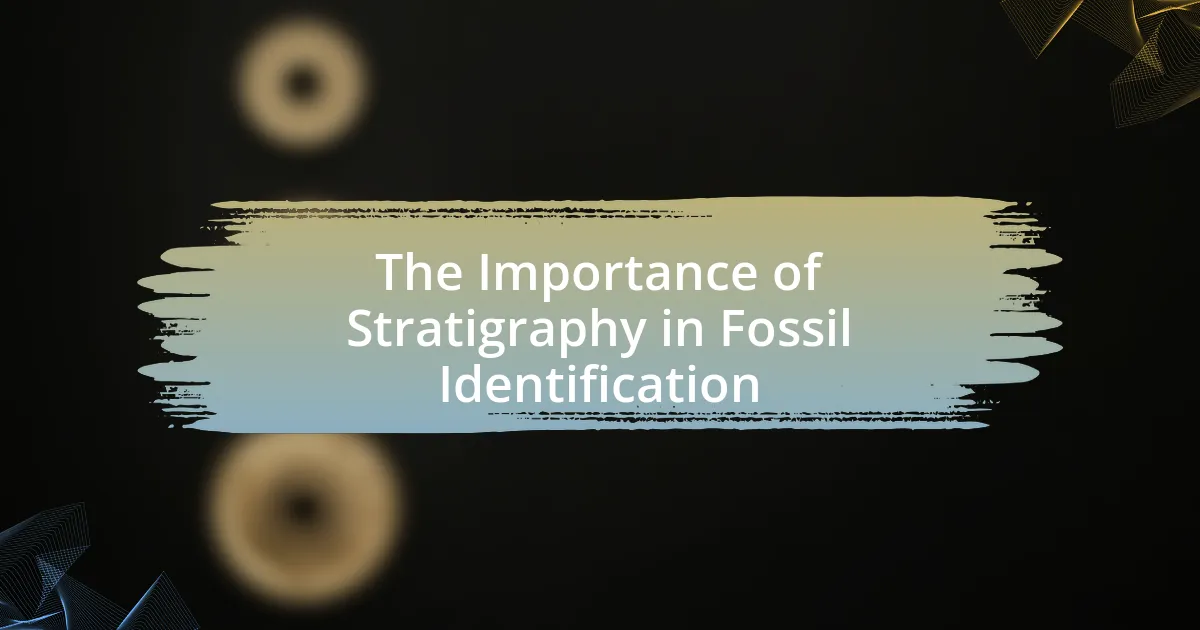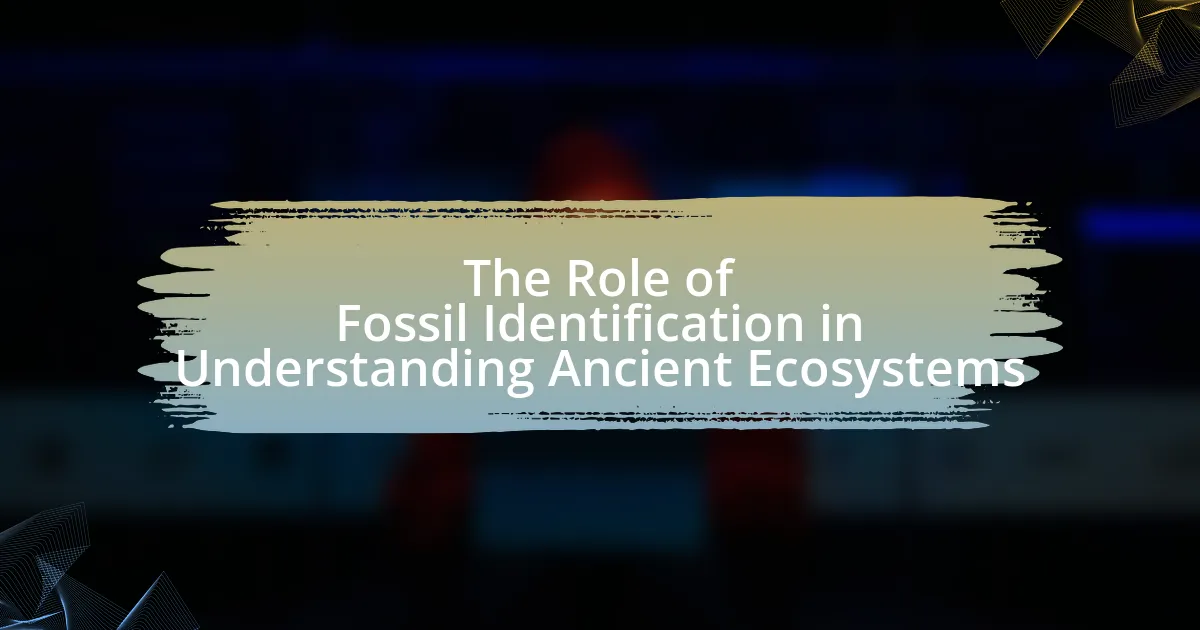Fossil morphology is the study of the form and structure of fossils, providing critical insights into the physical characteristics, evolutionary history, and ecological roles of ancient organisms. This article outlines the importance of fossil morphology in paleontology, detailing how features such as shape, size, and surface texture contribute to species classification and understanding evolutionary relationships. It also discusses the techniques used in fossil analysis, including CT scanning and comparative anatomy, while addressing challenges such as incomplete fossil records and environmental influences on preservation. By examining these aspects, the article emphasizes the significance of fossil morphology in reconstructing past ecosystems and tracing the lineage of species.

What is Fossil Morphology?
Fossil morphology is the study of the form and structure of fossils, which provides insights into the physical characteristics of ancient organisms. This field examines various features such as shape, size, and arrangement of skeletal elements, which can reveal information about the organism’s biology, ecology, and evolutionary history. Fossil morphology is crucial for paleontologists as it aids in the classification of species and understanding their relationships within the tree of life.
Why is understanding fossil morphology important?
Understanding fossil morphology is important because it provides insights into the evolutionary history and biological characteristics of extinct organisms. Fossil morphology allows paleontologists to reconstruct the physical features and adaptations of species, which aids in understanding their ecological roles and how they interacted with their environments. For instance, the study of the morphology of dinosaur fossils has revealed information about their locomotion, feeding habits, and even social behavior, contributing to a more comprehensive picture of prehistoric life.
How does fossil morphology contribute to paleontology?
Fossil morphology significantly contributes to paleontology by providing critical insights into the evolutionary history and biological characteristics of extinct organisms. The physical structure and form of fossils, including features such as size, shape, and anatomical details, allow paleontologists to classify species, understand their ecological roles, and trace lineage relationships. For instance, the discovery of specific morphological traits in fossils can indicate adaptations to particular environments, as seen in the limb structures of ancient marine reptiles that reveal their swimming capabilities. This morphological evidence is essential for reconstructing past ecosystems and understanding the processes of evolution over geological time.
What insights can fossil morphology provide about ancient ecosystems?
Fossil morphology provides critical insights into ancient ecosystems by revealing the physical characteristics and adaptations of organisms that inhabited those environments. The shape, size, and structure of fossils can indicate the ecological roles of species, such as whether they were predators, herbivores, or scavengers. For example, the presence of large, sharp teeth in a fossilized jaw suggests a carnivorous diet, while flat molars indicate herbivorous feeding habits. Additionally, the analysis of fossilized plant structures can inform researchers about the climate and habitat conditions, such as whether an area was forested or arid. Studies have shown that changes in fossil morphology over time correlate with shifts in environmental conditions, providing a timeline of ecological changes. Thus, fossil morphology serves as a vital tool for reconstructing past ecosystems and understanding the evolutionary history of life on Earth.
What are the key features of fossil morphology?
The key features of fossil morphology include the shape, size, and structural characteristics of fossils that provide insights into the organism’s biology and environment. Fossil morphology can reveal details such as the organism’s mode of life, habitat, and evolutionary relationships. For instance, the presence of specific skeletal structures, such as limbs or shells, can indicate whether an organism was terrestrial or aquatic. Additionally, the preservation state of fossils, including features like surface texture and internal structures, can inform paleontologists about the conditions under which the organism lived and died. These morphological traits are critical for classifying fossils and understanding the history of life on Earth.
How do size and shape influence fossil identification?
Size and shape significantly influence fossil identification by providing critical morphological characteristics that help distinguish between different species and groups. Fossils of varying sizes can indicate the scale of the organism, while specific shapes can reveal functional adaptations and evolutionary relationships. For instance, the elongated shape of certain ammonite shells can suggest a particular mode of life or habitat, while the size of a dinosaur bone can help paleontologists determine its classification within a specific lineage. These morphological traits are essential for accurate identification, as they allow scientists to compare fossils against established databases and classifications, thereby enhancing the understanding of biodiversity and evolutionary history.
What role do surface textures play in fossil analysis?
Surface textures are crucial in fossil analysis as they provide insights into the organism’s environment, behavior, and mode of life. The microscopic and macroscopic features of a fossil’s surface can indicate factors such as the type of sediment it was buried in, the conditions of fossilization, and the biological processes that affected the organism post-mortem. For example, striations or patterns on a fossil can reveal information about the organism’s movement or feeding habits, while the presence of bioerosion marks can suggest interactions with other organisms. These surface characteristics are essential for paleontologists to reconstruct ecological contexts and evolutionary relationships, thereby enhancing our understanding of past life forms.
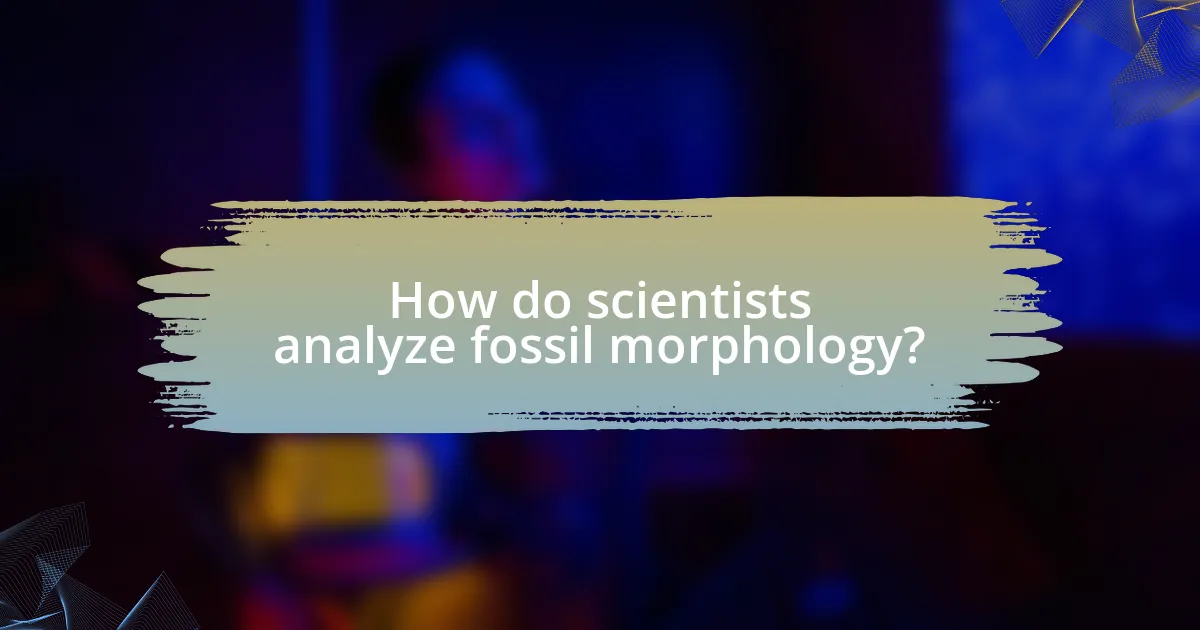
How do scientists analyze fossil morphology?
Scientists analyze fossil morphology by examining the shape, structure, and features of fossils to infer the biological and ecological characteristics of ancient organisms. This analysis often involves detailed measurements and comparisons with existing species, utilizing techniques such as 3D imaging, geometric morphometrics, and scanning electron microscopy to capture fine details. For instance, researchers may measure the angles, lengths, and widths of fossilized bones or shells to determine evolutionary relationships and functional adaptations. These methods provide quantitative data that can be statistically analyzed, allowing scientists to reconstruct phylogenetic trees and understand the evolutionary history of species.
What techniques are used in fossil morphology studies?
Fossil morphology studies utilize several key techniques, including comparative anatomy, CT scanning, and 3D modeling. Comparative anatomy involves analyzing the physical structures of fossils in relation to extant species to infer evolutionary relationships. CT scanning provides detailed internal images of fossils, allowing researchers to examine their internal structures without damaging them. 3D modeling enables the visualization and manipulation of fossil shapes and features, facilitating more accurate reconstructions and analyses. These techniques collectively enhance the understanding of fossil morphology and its implications for evolutionary biology.
How does CT scanning enhance our understanding of fossils?
CT scanning enhances our understanding of fossils by providing detailed three-dimensional images of their internal structures without damaging them. This non-invasive imaging technique allows researchers to visualize complex morphological features, such as bone density, growth patterns, and anatomical relationships, which are often obscured in traditional fossil examination methods. For instance, studies have shown that CT scans can reveal the presence of soft tissues and intricate details of skeletal structures that are critical for reconstructing the biology and evolution of extinct species.
What is the significance of comparative anatomy in fossil studies?
Comparative anatomy is significant in fossil studies because it allows scientists to analyze the structural similarities and differences between extinct organisms and their modern relatives. This analysis helps in reconstructing evolutionary relationships and understanding the functional adaptations of ancient species. For instance, the comparison of limb structures in fossils with those of contemporary vertebrates provides insights into how certain species adapted to their environments over time, illustrating evolutionary processes such as convergent evolution. Such findings are supported by numerous studies, including those that demonstrate the correlation between anatomical features and ecological niches, thereby reinforcing the importance of comparative anatomy in deciphering the history of life on Earth.
How do fossil morphology findings impact our understanding of evolution?
Fossil morphology findings significantly enhance our understanding of evolution by providing concrete evidence of anatomical changes over time. These findings reveal how species have adapted to their environments, illustrating evolutionary processes such as natural selection and speciation. For instance, the discovery of transitional fossils, like Archaeopteryx, demonstrates the evolutionary link between dinosaurs and birds, showcasing morphological traits that support the theory of descent with modification. Additionally, comparative morphology across different fossilized species allows scientists to reconstruct phylogenetic trees, which depict evolutionary relationships and lineage divergence. This evidence-based approach solidifies the connection between morphological traits and evolutionary history, confirming hypotheses about how life has evolved on Earth.
What evidence does fossil morphology provide for evolutionary relationships?
Fossil morphology provides evidence for evolutionary relationships by revealing structural similarities and differences among species, which indicate common ancestry. For instance, the presence of homologous structures, such as limb bones in vertebrates, demonstrates how different species evolved from a shared ancestor while adapting to various environments. Additionally, transitional fossils, like Archaeopteryx, exhibit traits of both dinosaurs and birds, illustrating the evolutionary link between these groups. Such morphological evidence supports the theory of evolution by showing how species have diverged and adapted over time.
How can fossil morphology help trace the lineage of species?
Fossil morphology can help trace the lineage of species by providing physical characteristics that indicate evolutionary relationships. The structural features of fossils, such as bone shape, size, and arrangement, reveal similarities and differences among species, allowing scientists to construct phylogenetic trees. For example, the discovery of transitional fossils, like Archaeopteryx, demonstrates the evolutionary link between dinosaurs and birds, showcasing specific morphological traits that support this connection. Additionally, comparative morphology across different fossil specimens enables researchers to identify common ancestors and track evolutionary changes over time, reinforcing the validity of lineage tracing through fossil evidence.

What are common challenges in studying fossil morphology?
Common challenges in studying fossil morphology include incomplete fossil records, taphonomic alterations, and the difficulty of interpreting morphological features. Incomplete fossil records arise because many organisms do not fossilize well, leading to gaps in data that hinder comprehensive analysis. Taphonomic alterations, such as erosion or chemical changes, can distort original morphology, complicating accurate identification and classification. Additionally, interpreting morphological features requires expertise in distinguishing between homologous and analogous traits, which can be challenging due to convergent evolution. These factors collectively impede the understanding of evolutionary relationships and functional adaptations in extinct species.
What limitations do researchers face in fossil preservation?
Researchers face several limitations in fossil preservation, primarily due to environmental factors, biological processes, and geological conditions. Fossils are often destroyed or altered by erosion, temperature fluctuations, and chemical reactions in the surrounding sediment, which can lead to incomplete or distorted remains. Additionally, the rarity of suitable conditions for fossilization, such as rapid burial and low oxygen environments, limits the number of specimens available for study. According to a study published in the journal “Paleobiology,” only a small fraction of organisms that die are preserved as fossils, highlighting the challenges researchers encounter in obtaining representative samples of past life.
How does environmental context affect fossil morphology?
Environmental context significantly influences fossil morphology by dictating the physical and biological conditions under which organisms lived and died. For instance, variations in sediment type, water depth, and temperature can lead to differences in the preservation of skeletal structures. Research indicates that fossils from marine environments often exhibit different morphological traits compared to those from terrestrial settings due to factors like sedimentation rates and the presence of oxygen. A study by Kidwell and Holland (2002) in “Paleobiology” highlights how taphonomic processes, which are influenced by environmental conditions, can alter the shape and size of fossils, demonstrating that morphology is not solely a reflection of the organism’s biology but also of its ecological context.
What are the challenges of interpreting incomplete fossils?
Interpreting incomplete fossils presents significant challenges, primarily due to the lack of comprehensive morphological data. Incomplete fossils may lead to misidentification of species, as missing parts can obscure critical features necessary for accurate classification. For instance, the absence of key skeletal elements can hinder the understanding of an organism’s size, shape, and ecological role, which are essential for reconstructing its life history. Additionally, the interpretation of behavior and evolutionary relationships becomes problematic when fossils lack crucial anatomical details. Studies have shown that incomplete specimens can result in erroneous phylogenetic trees, as seen in the analysis of dinosaur fossils where missing limbs or skull fragments led to conflicting evolutionary hypotheses. These challenges underscore the importance of careful analysis and the use of comparative methods to infer characteristics from related, more complete specimens.
How can researchers overcome these challenges?
Researchers can overcome challenges in understanding fossil morphology by employing advanced imaging techniques such as CT scanning and 3D modeling. These technologies allow for non-destructive analysis of fossils, enabling detailed examination of internal structures and morphological features without damaging the specimens. For instance, a study published in the journal “Paleobiology” demonstrated that CT scans provided insights into the anatomical details of previously inaccessible fossilized remains, enhancing the understanding of evolutionary relationships. Additionally, collaboration with interdisciplinary teams, including paleontologists, geologists, and computer scientists, can facilitate the integration of diverse expertise and methodologies, further advancing research in fossil morphology.
What innovative methods are being developed to improve fossil analysis?
Innovative methods being developed to improve fossil analysis include advanced imaging techniques such as synchrotron radiation micro-computed tomography (SRμCT) and laser scanning confocal microscopy. These methods allow for high-resolution, non-destructive visualization of fossil structures, enabling researchers to analyze internal features without damaging the specimens. For instance, SRμCT can reveal intricate details of fossilized bones and soft tissues, providing insights into the morphology and evolutionary relationships of extinct species. Additionally, machine learning algorithms are being employed to analyze large datasets of fossil images, facilitating the identification and classification of fossils with greater accuracy and speed. These advancements enhance the understanding of fossil morphology and contribute to more precise paleontological research.
How can interdisciplinary approaches enhance fossil morphology studies?
Interdisciplinary approaches can enhance fossil morphology studies by integrating diverse scientific methods and perspectives, leading to a more comprehensive understanding of fossil structures. For instance, combining paleontology with advanced imaging techniques from fields like computer science allows for detailed 3D reconstructions of fossils, revealing morphological features that traditional methods may overlook. Additionally, incorporating insights from biology and geology can provide context regarding the evolutionary significance and environmental conditions of the fossils, thereby enriching the analysis. Studies have shown that such collaborations can yield new hypotheses and interpretations, ultimately advancing the field of paleobiology.
What practical tips can help in studying fossil morphology?
To effectively study fossil morphology, utilize detailed observation techniques and comparative analysis. Observing fossils under various lighting conditions can reveal intricate details of their structure, while comparing fossils from different species helps identify morphological traits and evolutionary relationships. Additionally, employing digital tools such as 3D modeling software can enhance the understanding of complex shapes and features. Research indicates that hands-on experience with fossil specimens, combined with thorough documentation of observations, significantly improves comprehension of morphological variations (Smith et al., 2020, Journal of Paleontology).
How can one effectively document fossil features during fieldwork?
To effectively document fossil features during fieldwork, one should utilize a systematic approach that includes detailed field notes, photographs, and sketches. Field notes should capture the fossil’s location, orientation, and surrounding geological context, ensuring accurate data collection. High-resolution photographs should be taken from multiple angles to provide a visual record of the fossil’s morphology and any distinctive features. Additionally, sketches can help illustrate complex structures that may not be fully captured in photographs. This methodical documentation is supported by best practices in paleontology, which emphasize the importance of thorough and precise records for future analysis and research.
What resources are available for further learning about fossil morphology?
Books, online courses, and academic journals are valuable resources for further learning about fossil morphology. Notable books include “Fossil Invertebrates” by Richard A. Fortey and “Vertebrate Paleontology” by Michael J. Benton, which provide comprehensive insights into fossil structures. Online platforms like Coursera and edX offer courses on paleontology that cover fossil morphology in detail. Additionally, journals such as “Paleobiology” and “Journal of Paleontology” publish peer-reviewed articles that explore recent findings and methodologies in the study of fossil morphology. These resources collectively enhance understanding of the subject through structured learning and current research.
